UN Secretary-General Ban Ki-moon's
Zero Hunger Challenge
ACWW represents more than 9 million women around the world. Through our women-to-women projects and with the support of our members, we pledge to work to eliminate hunger in our life-times:
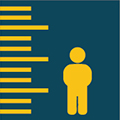
Zero stunted children less than 2 years old
- Encourage healthy mothers to breast-feed their children for longer*
- Recommend appropriate and nutritious weaning foods
- Ensure that the children of project beneficiaries are properly vaccinated

* ACWW has already passed a resolution in support of this statement
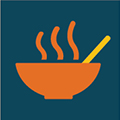
100% access to adequate food all year round
- Identify the hungry period and recommend local food crops that are nutritious and can provide food all year round*
- Support farmers' Rights to Plant Genetic Resources* and ensure that project beneficiaries have access to seed for a wide range of nutritious food crops
World Hunger Map
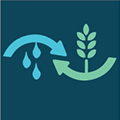
All food systems are sustainable
- Recommend and support organic / agroecological methods to maintain soil fertility and conserve moisture
- Recommend safe, effective, alternatives to toxic pesticides
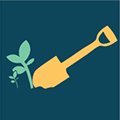
100% increase in smallholder productivity & income
- Help smallholders to record their crop yields
- Help smallholders to record their input costs
- Help smallholders to calculate and record their income and profit
- Ensure that this information is collected at the beginning, during and end of each project so that any increases in productivity can be accurately measured
UNICEF Info Sheet:
El Niño’s impact on children

Zero loss or waste of food
- Encourage the many thousands of ACWW members and societies around the world to prevent food loss and campaign against food waste. Their success stories will be monitored via traditional methods (reporting, email) as well as newer forms of contact such as Facebook and through the use of WhatsApp
ZHC BLOG:
5 Questions for Nagaluma Margaret Kasozi;
Maganjo Farmers Association, Uganda
Ruth Shanks AM
World President
Associated Country Women of the World
ACWW's Zero Hunger Challenge Projects
ZHC Project 5
ZHC Project 4
ZHC Project 3
ZHC Project 2
ZHC Project 1
ACWW Zero Hunger Challenge Project No.5
Project
ACWW Project No.1009:
Ufanisi Women's Group (UWG)
Improving food and nutrition security for young mothers and their children, through dairy goat rearing
The Challenge
Young women in Bungoma, western Kenya have an average income of just KES985 or USD9.50, per month and are unable to grow sufficient maize to feed their families. These households had an annual maize grain shortfall of between 300 and 2,100 kg (an average short-fall of 932.5 kg). Maize yields are low because:
• The women use unselected, recycled maize seed.
• Their plots are too small, considering the size of their families.
• The soil is infertile due to continuous monocropping with maize, while they are too poor to buy fertilisers.
• They do not follow recommended agronomic practices, such as rotation with legumes or proper plant spacing.
As a result, both women and children in the area are suffering from severe malnutrition: Signs in women include chronic fatigue (indicating iron deficiency) slow healing wounds (indicating vitamin C deficiency) and dry brittle hair (indicating overall vitamin deficiencies). Signs in children include stunting and the loss of hair pigmentation (indicating chronic under-nutrition) also dry scaly skin (indicating a lack of B vitamins, especially niacin).
Most of the women in the project area breastfeed their children for more than two years, although this protects children from malnutrition during this time, pregnancy and breastfeeding make women even more vulnerable to energy and nutrient deficiencies.
Violet the Goat in her shed; and Project Beneficiary Jenipher Walunywa milking her dairy goat
Can a goat-rearing enterprise improve food & nutrition security?
Farmers can benefit from rearing high yielding, stall-fed, dairy goats in terms of a daily milk supply that can be consumed by family members and sold to neighbours, kids that are produced every sixteen months and can be used either for meat for home consumption or sold in the local market, as well as manure that can be used to increase soil fertility. Goats’ milk is high in protein, fat, calcium and vitamins A and B and is a high quality food for young and old.
The Ufanisi Women’s Group used their links with the Mabanga Farmers’ Centre to implement a dairy goat rearing project in order to reduce poverty and improve food and nutrition security for young mothers and their children in Bungoma.
Twenty of the most vulnerable women were selected for the project. Each of these women received training in goat-keeping and help in the construction of a weather-proof, animal shelter, using local materials. They were then each given a Toggenburg, dairy goat, which began lactating within six months, following the birth of one or two kids. The women were able to keep one litre of goat’s milk each day to feed their families and sell approximately two litres per day, at KES100 per litre. The first weaned kids were passed on to other women in the project. All beneficiaries are responsible for repaying KES34,500 (the cost of the impregnated goat) into the project’s revolving fund to enable more women to benefit from the project in future.
Several financial costs and benefits accrued to each farmer, from this project:
Farmer’s costs
• Daily fodder and supplementary feed
• Occasional Veterinary treatment
• Monthly repayments into project revolving fund, during the first three years
Farmer’s benefits
• Income from daily milk sales
• Income from selling two goat kids, once every 16 months
Were the women able to profit from this goat-rearing enterprise?
Each woman made a profit of KES2,300.00 per month from selling goat’s milk every day and two goat kids every 16 months.
Did they make sufficient profit to pay for their household’s maize short-fall?
The maize short-fall was determined according to the energy needs of each household. The daily energy requirement for pregnant or breastfeeding women, men, adolescents and children is measured in kilocalories (kcals), see Table 1. One kilogramme of maize grain provides 3.7 kilocalories.
Table 1. Calculating the minimum annual amount of maize grain needed per household
Person Type
Minimum KCals needed per day
Minimum KCals needed per year
Minimum amount of maize grain needed per year (1kg of maize produces 3.7KCals)
Pregnant / Breastfeeding woman
2.5
912.5
250kg
Man
2.5
912.5
250kg
Adolescent 10 to 18 years
2.0
730.0
200kg
Child under 10 years
1.5
547.5
150kg
Each of the 20 households that participated in the dairy goat project contained an average of two adults (range 1-6) two children under 10 years (range 1-3) and one adolescent, aged 10-18 years (range 0-4). This means that the average minimum amount of maize grain required by each household is 1,172.5 kg per year.
These households reported that they harvested only 240kg of maize grain, on average. This left an average short-fall of 932.5kg of maize per household, per year. The cost of buying sufficient maize to cover this short-fall, @KES80 per kg, is KES74,600.00 per household. At the beginning of the project, monthly household income ranged from nought to KES2,000 (an average of KES985). This was insufficient to pay for the additional maize required.
At the end of the project, the difference between the costs and benefits from goat rearing was calculated for each household. When the profit was added to the previous income it came to an average of KES66,420.00 (range KES54,600.00 to KES78,600.00) per household, per year.
This amount will enable 10 (50%) of the households to buy enough maize grain to be food secure; households lacked an average of KES8,180.00, which is needed to guarantee food security in maize, see Table 2. This is because the poorest farmers have larger families with little or no income to add to the funds gained from the goat enterprise.
Cost of covering
short-fall*
Annual income** from selling goat milk/kids (KES/yr)
Remaining after payment for short-fall*
Households receiving
goats
Adults per household
Children
<10 years
Youth
10-18
years
Min. annual maize needed (kg)
Maize harvested (kg)
Maize shortfall
(kg)
74,600.00
932.5
66,420.00
-8,180.00
20
2
2
1
1,172.5
240
* KES (Kenyan Shilling) - approximate value as of June 2017 ≈ 0.00965US$ / 0.00762 £GBP
** Expected income based on prevailing economic conditions
The Ufanisi Women’s Group reported that the women will be able to increase maize yields in future by using goat manure to improve soil fertility. They will also be able to use some of their income from dairy goats to buy improved seed and lease more land to expand their maize crop.
It was reported that the regular consumption of goat’s milk by the children had improved growth and development and caused their skin and hair to return to normal. Their mothers said that they felt stronger and more energetic as a result drinking goat’s milk every day. These women have been advised to interplant their maize garden with cowpea (black-eyed bean) to increase soil nitrogen and provide leaves and beans that are rich in iron and vitamin C – two important nutrients that are lacking in goat’s milk.
ACWW Project No.983:
Magango Farmers' Association (MFA) - www.mafauganda.org
Increasing household food security and incomes among 100 rural women-led families in Uganda
A baseline study conducted in 2012 showed that malnutrition, linked with food insecurity is a serious problem for households in Bamunanika Sub-county, Luwero District, Uganda.
This project was implemented by Majango Farmers’ Association (MAFA) and aimed to improve food and nutrition security for 100 women-led households in Bamunanika. The women grew maize, cooking banana or sweet potato as their main food staple. Part of this food staple was sold for cash. The amount harvested, energy short-fall and cost-benefit ratio from crop sales was calculated using data collected by the MAFA in order to determine whether the farmers could meet their household energy needs and profit from selling surpluses:
Table 3. Means from 100 subsistence farming households in 2016
| Landholding | Breastfeeding time for last child |
House- hold size |
Annual minimum energy requirement |
Crop yield this season |
Energy short-fall* |
Weight of crop sales** |
Input costs (USh) |
Cost-Benefit Ratio from crop sales |
|---|---|---|---|---|---|---|---|---|
| 54 Maize Growers |
||||||||
| 0.82 ha (range: 0.02-6.1 ha) |
12.1 months |
6 |
4,308 Kcals |
1,478 kg (range: 0-2,900 kg) |
-2,538 Kcals |
993 kg |
233,426 |
1.7 (range: 0-11.5) |
| 32 Cooking Banana growers |
||||||||
| 0.91 ha (range: 0.02-2.8 ha) |
12.8 months |
5 | 3.798 Kcals |
694 kg (range: 200-1,100 kg) |
-2,861 Kcals |
160 kg |
192,942 |
0.7 (range: 0-2.8) |
| 14 Sweet Potato growers |
||||||||
| 1.17 ha (range: 0.3-2.8 ha) |
12.6 months |
5 | 3,884 Kcals |
1,698 kg (range: 450-3,600 kg) |
-1,846 Kcals |
1,050 kg |
45,978 | 6.8 (range: 0-20.3) |
| * calculated from this season's yield of the staple food crop | ** 'distress sales' |
|||||||
Notes
Most children got off to a healthy start, as they had been breast-fed for 12 months or more.
On average, each household consisted of 2 adults and 3 children;
The minimum daily energy requirement for adults is 2.5 Kilo calories;
For children over 10 years it is 2.0 Kilo calories;
For children under 10 years it is 1.5 Kilo calories.
Therefore, each household requires between 3,884 and 4,308 K calories for a whole year. Women farmers from these households produced maize, cooking banana or sweet potato as their food staple:
• 1 Kg of maize grain provides 3,650 calories (3.7 Kilo calories)
• 1 Kg of cooking banana provides 1,350 calories (1.4 Kilo calories)
• 1 Kg of sweet potato provides 1,200 K calories (1.2 Kilo calories)
Considering the size of their households, most farmers were unable to provide sufficient food staple to meet their annual energy needs, from maize, cooking bananas or sweet potatoes. This means that farmers who sold part of their harvest were making ‘distress sales’ in order to recover input costs. These farmers will have to buy energy-rich food later in the year in order ensure household food security.
Farmers who made the most profit had the lowest input costs. This means that it is possible to improve food security and make a profit from sales by reducing input costs as well as by increasing yields.
The Cost-Benefit Ratio is the ‘profit’ divided by the ‘input costs’. This should be at least 2.0 to make the enterprise worthwhile, i.e. the value of the profit should be at least twice the input costs. A cost-benefit ratio of 1.0 means that the farmer broke even, but there was no profit. If it is less than 1.0 then the farmer made a loss. The average cost-benefit ratio for the sales of both maize and cooking banana was less than 2.0. Only the sale of sweet potato produced an average cost-benefit ratio of more than 2.0, with profits ranging up to 20 times the input costs.
The outcome of this work demonstrates how difficult it is for subsistence farmers, with landholdings of less than 1 ha, to grow sufficient food to guarantee household food security and also obtain a surplus which can be sold to cover the cost of their inputs.
ACWW Zero Hunger Challenge Project No.4
Project
Background
ACWW Zero Hunger Challenge Project No.3
Project
ACWW Project No.1009:
Ufanisi Women’s Group
Dairy Goat-Rearing for young Mothers in Ufanisi Location, Bongoma District Kenya
Sponsors
Country Women's Council, USA
www.cwcusa.org
The women selected for this project by the Ufanisi Women’s Group are poorly educated and have access to small landholdings, less than 0.5 acres in size. This means that they are unable to grow sufficient maize to feed their families - on average each household has an annual short-fall of 932kg. They also lack seed to grow vegetables and other nutritious food crops. Most of the women do casual labouring work to try to make ends meet, but average incomes per household amount to less than US$ 10 per month, this is insufficient to cover the US$ 737 required to pay for the additional maize needed for food security, let alone for school fees and medical expenses.
Additional data collected showed that the children were breast-fed for an average of 14 months, however, all women and children displayed signs of chronic malnutrition, which was affecting child growth and development, while their mothers are suffering from chronic fatigue and complained of wounds that are slow to heal.
Considering the extent of malnutrition in Ufanisi Location, in terms of both food quantity and quality, it is highly likely that the women are not only deficient in carbohydrate, but also in iron and vitamin C.
Background
Home consultations are carried out in the Ufanisi region
Project beneficiaries
Table 2. Baseline Data reported at commencement of project
Women involved in the project
Income before project
(US$ per month)
Adults per household
Children per household
Breast-feeding time
(months)
Maize
short-fall (kg)
Cost of buying sufficient maize to cover shortfall
20
9.7
2
3
14
932
737 (US$/year)
Mrs Dolphine Lavin of the Ufanisi Women’s group said, “Truly, food is a critical and pressing challenge within many households here in Kisiwa location. Maize is the staple food crop, but there are ever dwindling yields and the cost of buying maize per kilo is also increasing. The cost of one 50 Kg maize bag is currently trading at KES4,000 (US$ 40 ) but may go as high as KES6,000 (US$ 60) between January and August every year. Therefore it is extremely difficult for these extremely poor and vulnerable women to get enough to eat in their households. They just cope with the situation by going hungry for some days and nights, since they don't produce what is enough for them and their families and lack any other form of assistance".
ACWW Zero Hunger Challenge Project No.2
Signs and symptoms of food poisoning
Jamshed displays food hygiene rules: cook at the correct temperature; separate cooked and uncooked food; clean hands and surfaces; chill unused food
Project
Sponsors
Background
ACWW Project No.995:
Flame Foundation Pakistan
Raising women’s awareness of the importance of hygiene, nutrition and breast-feeding in promoting family health
Les Cercles de Fermières du Québec
150 rural women were trained in food hygiene, how to produce and cook nutritious food and the importance of breast-feeding infants, by the Flame Foundation.
Many Mothers in Punjab are unaware of the importance of breast-feeding, while their families are eating ‘junk food’ (deep fried pakora and samosas from local traders) rather than home-grown fruits and vegetables. Most families are self-sufficient in wheat, but eat animal protein less than three times per month and consume a diet that is low in protein, iron and essential vitamins. The most common ailments reported by the women were skin, eye and lung infections, bleeding teeth, gastric problems and diarrhoea.
Many of the women had been married at 15 years of age and had each given birth to an average of four children. Complications during pregnancy due to anaemia, including maternal death, is not uncommon.
Flame held five ‘health and nutrition education’ sessions for five groups of 30 women. A range of colourful posters and booklets, in both English and the vernacular were specially printed in order to spread the health, hygiene and nutrition messages for food preparation
Outcome
Data collected by the Flame team showed that 32% of the mothers had breast-fed their babies for less than 3 months, although the overall average was just 3.5 months. Some younger women had been persuaded to use infant formula. Others complained of insufficient breast milk to enable them to feed their infants for the recommended six to twelve months. During the training mothers learned of the importance of a healthy diet so that their next baby could be breast-fed for at least 12 months and thus be protected against diarrhoea and other infections.
The women were encouraged to plant vegetables in kitchen gardens in order to provide nutritious food for the whole family. They used compost and cow manure to fertilise the soil. They prepared seed beds and planted a range of different squashes, including apple gourd; also brinjal, okra and radish.
Husbands were also invited to attend Flame’s Farmer Field Schools. Some of them regretted that reliance on chemical inputs and tractors had led to the loss of dairy cattle and said that this had contributed to household food insecurity.
Three months after the training, local shop keepers said there had been a decline in sales of pakora and samosas. Some health benefits were also reported by the women.
Rule 1: Always wash hands with soap
Demonstrating safe food preparation
Breast-feeding is not a choice - its a responsibility!
Women attended Farmer Field Schools and learned how to grow a range of vegetables
Farmer's seed bed
'Tinda' or apple gourd
Brinjal
Husbands join in the Farmer Field Schools
ACWW Zero Hunger Challenge Project No.1
Project
Sponsors
Background
Outcome
ACWW Project No.973:
To construct two large poly-tunnels to enable the production and sale of nutritious vegetables in Khovd Aimag, Western Mongolia
Country Women's Council, USA
www.cwcusa.org
Average temperatures over most of Mongolia are below freezing from November through to March and are at about freezing in April and October. This means that the growing season for vegetables in Western Mongolia, is just three months long, that is, from June to August. As a result vegetables are both scarce and unaffordable for most people.
With the help of the Sain Tus Center, two groups of 15 women from female-headed households formed co-operatives to produce and market a range of nutritious vegetable crops. Some of these vegetables were transplanted into the field once the temperatures were high enough, while the more tender crops, such as cucumbers and peppers were allowed to mature inside the plastic houses. Animal manure was used to fertilise crops.
Yields were high during the first year (2015) and each farmer profited by as much as 1,124,917 Mongolian Tughriks or US$ 566.87, once the produce had been sold in the local market, see Table 1.

Women tending their crops inside the Poly-Tunnel

Cucumber ready for harvest
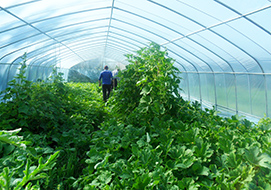
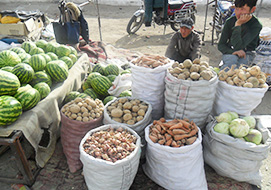
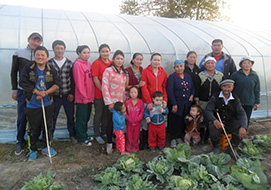
Significant growth in the Poly-Tunnel
Harvested crops ready for market
Farmers & children with their Poly-Tunnel
Table 1: Costs and benefits of vegetable production in two Poly-Tunnels in Khovd Aimag, Western Mongolia
| Vegetable Crops |
Input costs* (US$) |
Yield (kg) |
Selling price per kg (US$) |
Income (US$) |
Profit (US$) |
|---|---|---|---|---|---|
| Cabbages | 1,034.35 | 8,691 | 0.30 | 2,607.30 | 1,572.95 |
| Carrots | 653.96 | 5,874 | 0.40 | 2,349.60 | 1,695.64 |
| Cucumbers | 836.38 | 3,983 | 0.60 | 2,389.80 | 1,553.42 |
| Onions | 468.34 |
3,112 | 0.50 | 1,556.00 | 1,087.66 |
| Peppers | 260.90 | 1,246 | 0.60 | 747.60 | 486.70 |
| Potatoes | 917.10 | 9,695 | 0.33 | 3,199.35 | 2,282.25 |
| Tomatoes | 2,336.67 | 6,410 | 1.51 | 9,679.10 | 7,342.43 |
| Turnips | 291.96 | 4,257 | 0.30 | 1,277.10 | 985.14 |
*Input costs were for seed, manure, pesticides, irrigation, labour and transport
ACWW Projects
Agriculture
ACWW & The United Nations
Zero Hunger Challenge
Triennial World Conference
Translate this page
This page can provide an automated translation via Google Translate. ACWW cannot accept any liability for the quality of the translation.

Associated Country Women of the World
24 Tufton Street, London SW1P 3RB
United Kingdom
Registered Charity No. 290367
Terms, Conditions and
Legal Policy Statements
© ACWW 2017 unless otherwise stated

.svg?crc=27030969)